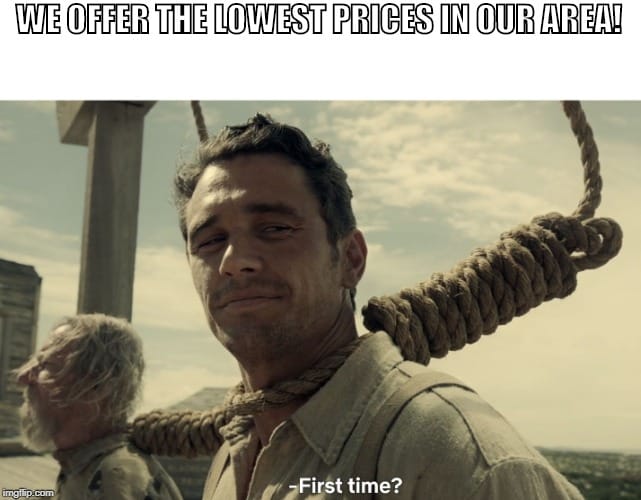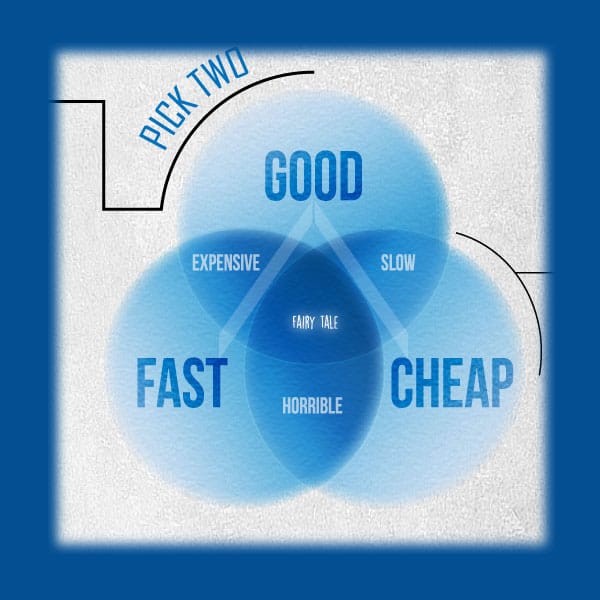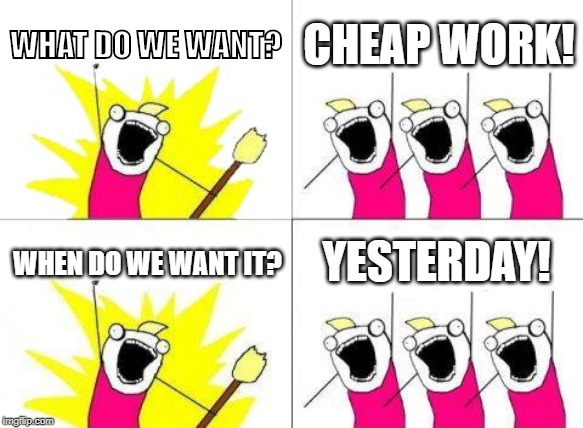Every so often, we come across someone in our industry who wants to be competitive. Most of the time, there’s only one point on which they will attempt to stake their claim as the best option, and I know you’ve encountered these people as well. What is this point I speak of? Pricing. A lot of times this claim is shrouded in various forms such as “best bang for the buck,” “budget-friendly,” or it could be as in-your-face as claiming to have “the lowest prices in the area.”
A couple of things cross my mind when I see someone offering the lowest prices: A) this company has no grasp on the real value of the service they provide; B) they don’t understand how a trade-service industry works.


The Triangle
It’s likely you’ve seen us post about this triangle before. The theory behind the triangle is that each point has a value (fast, good, cheap) and you can only pick two.
By proxy, if you are in a trade-service industry, you can only realistically offer two. You can attempt to offer all three but, eventually, your business will fail.
The deceptive beauty of attaining all three is that it would seem that you have found the trifecta. It’s the perfect balance and you will have more work than you know what to do with.
The Problems
Once you find the three point balance, there are some inherent problems. These are where “it’s too good to be true” really shines through.
Problem 1: More work than you know what to do with
I know you’re likely thinking, “how on earth could you call this a problem?” It’s really quite simple: eventually, you will sacrifice one of the three points. Either you do the jobs well, and, because of the amount of business you’ve taken on, you lose the ability to do them fast, which results in unhappy customers. Alternately, you do the jobs fast, but have too much volume to do them well, resulting in, you guessed it, unhappy customers.


Problem 2: Bottom feeder customers
It’s been our experience, and many others will back us up on this, that the cheaper the customer, the harder they are to work with. (Sidenote: there are exceptions to this statement, particularly with good non-profit organizations who just don’t have the money, but, will do everything they can to bring value to the transaction. There are also businesses who fall into this category and you can tell how good a client they are by how well they respect your time and energy)
Most of the time, interactions with these customers go like this:
They start off by telling you they can’t afford your service (often before you even tell them how much it will cost), but try to offset it by telling you how much business they can bring you.
Sounds like a good deal. So, you have your meeting, gauge what their needs are, and make a basic decision on what direction their project should go.
You leave the meeting and get to work on preparation. Once you’ve nailed something down, you set up another meeting with them. You arrive at the meeting and one, if not more, things happen. You begin to discuss your idea and it’s obvious they aren’t listening because they are waiting for you to stop talking long enough for them to share some ideas of their own. This wouldn’t be bad, except they have nothing to do with what you initially discussed and will definitely fall outside of the budget you’ve both agreed to. No matter how much you try to redirect the conversation, they keep adding more (we call these “scope-creepers”).
In an effort to keep them happy, you listen and wait until you get to discuss what you went there to discuss. Eventually, they agree on the direction (again), and you begin work on the project.
All of a sudden, you’re getting emails, texts, and phone calls that are filled with, “hey, I have an idea… What if we did [fill in the blank]?”
Before you know it, because you want to keep them happy, you agree to everything and your workload has tripled and you’re not making anymore money. Booo.
Alternately, they want to be extremely involved in your processes and are constantly questioning you or telling you how they think it should be done. This, again, leads to an increase in your workload and no more money, and, often times, by the end of the project nobody is happy with it and your customer is mad at you because you said you were a professional. It doesn’t matter that they are the one who torpedoed it, and you have an angry ex-customer.
Problem 3: You lose yourself
This one stings for those of us who are continually attempting to grow and get better.
We’ve all seen the individual who has been doing their job for 20 years and their work looks exactly like it did 20 years ago although the rest of the world has moved forward. They’re complacent and they don’t seem to really care about what they are doing anymore. This comes from chasing a quick dollar over self-improvement.
I actually quit a job because I was told my work was too good and that those in charge didn’t want our customers to expect work that good. I was dumbfounded and I resigned. There was no place for me there.
This result is an eventuality. If you want to remain cheap, then you cannot deliver a superior product with any sustainability, and you end up in a rut.
Earl Nightingale said, “a rut is a grave with the ends kicked out,” and that’s exactly where your spirit and your business will end up: in an early grave.

Problem 4: You’ve set yourself up for failure
Once you’ve established that you are the low-hanging fruit, it’s extremely hard to raise your perceived value in your market.
This is by far the biggest obstacle that, I believe, those in trade-service industries face when they compete on pricing. Once you’re the cheap option, you’re always the cheap option.
Follow me here: let’s say you need to get your car worked on and you find the cheapest mechanic you can. He “fixes” your car and you go on your merry way. In this story, you have three options:
- The next time your car needs a repair, you return because he is still cheap. However, this time, you pull up to his garage and can’t even find a place to park because there are so many vehicles in line to get fixed. When you talk to him, he tells you that he can definitely fix your problem cheap, but it’s going to take him at least a month to get to it because he is snowed under.
- He didn’t really fix the car in the first place and you are going to have to pay him again to fix problems caused by his first fix.
- You car has a new problem and you liked his work, the first time. This time, however, he lets you know that his pricing has gone up because he spent the money and time to upgrade his certification and he can now do a better job for you and get it done quickly.
These options kind of suck since you were just looking for the cheapest fix possible. Also, in case you missed it, let me simplify what you are sacrificing with each option:
- Fast
- Good
- Cheap
You can’t have all three.

Final thought
If you want to compete on being the lowest price, in one for or another, you are committing false economy (more on that concept here). In short, either you will lose money by taking on too much quantity, you will lose money by giving up too much of your time (unpaid), or your customer will be losing money by getting a subpar product (whether it’s their fault or yours).
In short, if you want to be in a business that competes solely on price, buy a gas station. If you want to offer more to your customers, get good at what you do, figure out your dollar value and stick to it. Ultimately, you will find more satisfaction in your work, you will work with more customers who give you energy rather than stealing it from you, and you can be proud of who you are and what you do.

Recent Comments